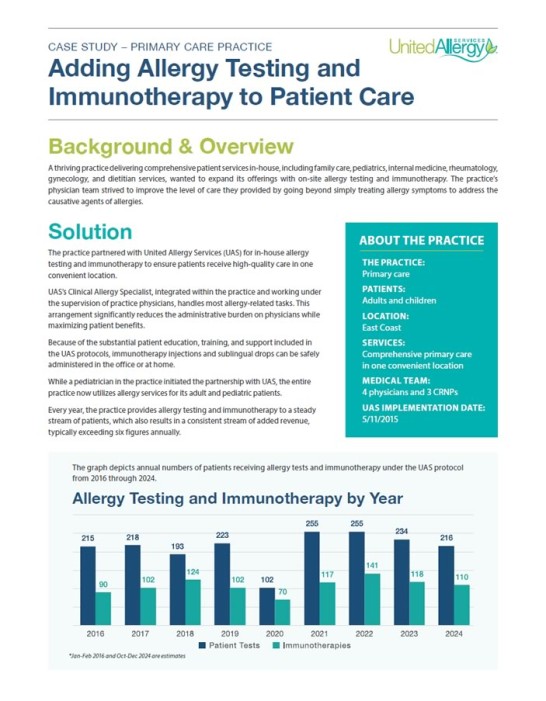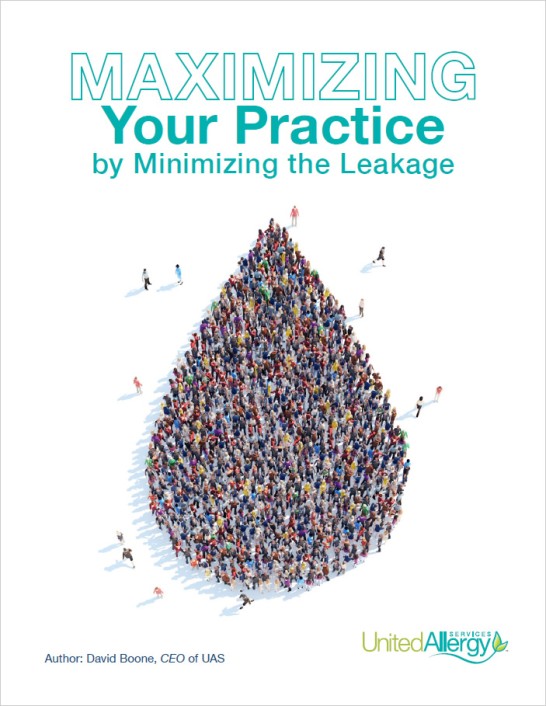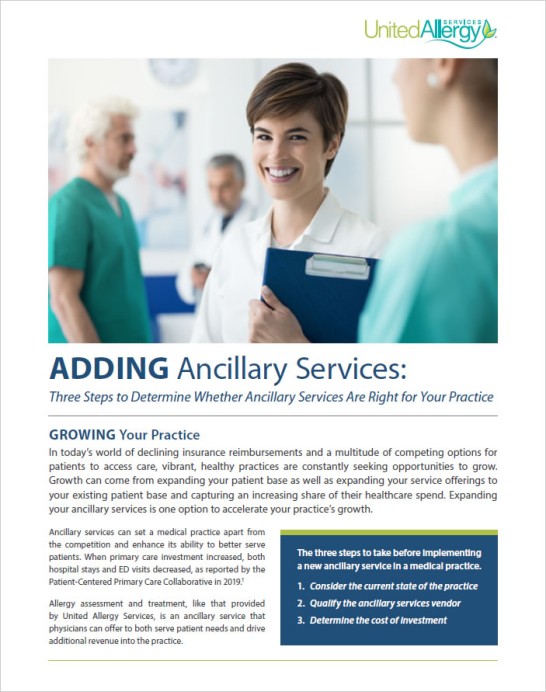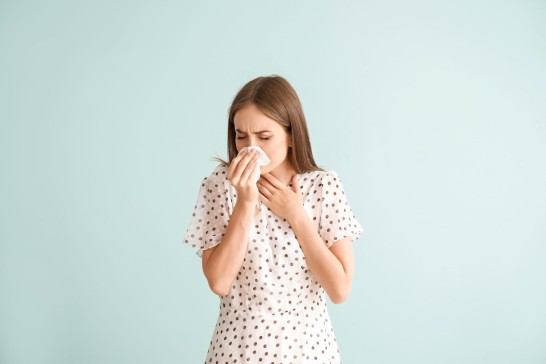Allergy Services for Primary Care Physicians: Expanding Access to Long-Term Allergy Relief
Allergies affect more than 100 million people each year. Yet despite their widespread impact, allergies often go untreated due to the scarcity of specialist care. That’s why United Allergy Services is focused on introducing allergy treatment and immunotherapy to primary care practices—the first and often only point of contact for patients suffering from allergies. Let’s look at how UAS is making allergy care part of primary care.
Allergies are among the most common chronic conditions in the United States. Yet, despite the prevalence of food and environmental allergies and the associated health complications—including allergic asthma, sinus infections, and even anaphylaxis—many patients never receive proper diagnosis or treatment. Instead, they rely on over-the-counter medications that only mask symptoms rather than addressing the root cause.
Allergy Care Is Primary Care
Primary care physicians (PCPs) are often the first and only point of contact for patients suffering from allergies. By incorporating allergy testing and immunotherapy into their practice, PCPs can offer their patients a comprehensive, long-term solution, without the need for frequent specialist referrals. Allergy immunotherapy is the only treatment proven to modify the immune response to allergens, providing lasting relief rather than temporary symptom control.
United Allergy Services: Bringing Allergy Testing & Treatment to PCPs
United Allergy Services (UAS) partners with primary care providers to offer in-office allergy testing and customized immunotherapy treatment, enabling them to expand their scope of care with minimal additional workload. Since 2009, UAS has successfully partnered with over 2,500 practitioners across more than 20 states.
How UAS Supports PCP Practices
UAS offers two models for PCPs: a UAS-staffed Allergy Center or a self-managed Testing & Immunotherapy Kit package.
The UAS Allergy Center is fully supplied, staffed and managed by UAS. It is designed to integrate seamlessly into the practice with minimal disruption or outlay. This program includes:
- Clinical Allergy Specialists (CAS): Trained, onsite professionals who educate patients, conduct allergy testing, and coordinate immunotherapy.
- Comprehensive Food and Environmental Allergy Testing: Identifies sensitivities to pollen, dust mites, mold, and pet dander as well as certain foods (e.g. peanuts, lactose).
- Custom Immunotherapy Plans: Based on proprietary protocols, personalized allergy treatment options include subcutaneous (allergy shots) and sublingual (allergy drops) to maximize patient convenience and adherence.
- Full-service Supply & Compliance Management: UAS handles all allergy center supplies, from test extracts to patient education materials, ensuring a seamless experience.
- Insurance & Billing Support: Our team assists with reimbursement processes, making allergy services accessible and affordable for both patients and practices.
With the UAS Testing & Immunotherapy Kits, practices can enhance patient care while maintaining flexibility in how allergy services are incorporated. The Kit option includes:
- Environmental Allergy Testing Kit: Screens for 54 regionally relevant allergens, including trees, grasses, weeds, molds, and pet dander.
- Food Allergy Testing Kit: Identifies sensitivities to 23 common food allergens with panels tailored for adult and pediatric patients.
Both kits include personalized subcutaneous or sublingual immunotherapy options through UAS’s prescription-based formulations.
The Value of Experience
United Allergy Services has an unequalled record of success in delivering effective allergy treatment:
- UAS has more patients on our protocol than any other allergy service provider in the United States.
- We have partnered with more than 2,500 providers in 20+ states to provide allergy testing and immunotherapy services.
- Since 2011, UAS has conducted over 575,000 allergy and food sensitivity tests and served over 350,000 patients with 36+ million immunotherapy treatments in our allergy care clinics.
Enhancing Allergy Care in Primary Practices
With limited access to allergy specialists, many allergy sufferers and their doctors are forced to rely on medications that only mask allergy symptoms, increasing the risk of patients developing long-term respiratory conditions such as asthma.
By partnering with United Allergy Services, primary care practices are able to provide convenient, in-office testing for the full range of allergies and food sensitivities along with safe, well-proven immunotherapy.
Patients enjoy dramatic improvements in quality of life while PCP practices achieve higher levels of patient care and overall satisfaction.
United Allergy Services Featured in Fujitsu Case Study
We are happy to share that United Allergy Services was recently featured in a Fujitsu case study highlighting how we achieve precise inventory tracking and process automation to enhance patient safety and efficiency. The case study explores how UAS leverages Fujitsu’s GLOVIA® OM solution, in conjunction with Salesforce, to improve the allergy care services we offer through our provider partners.
How UAS Improved Efficiency and Operational Care with GLOVIA® OM
As a leading provider of allergy testing and immunotherapy solutions such as allergy shots and allergy drops, UAS partners with healthcare providers to deliver effective and personalized allergy care. Managing thousands of patient interactions daily requires a robust and scalable system that ensures accuracy, compliance, and efficiency.
To help address these needs, UAS implemented GLOVIA® OM, a solution from Fujitsu designed to optimize data management and logistics. This system has improved the way we manage and track inventory, and helps ensure patient safety and regulatory compliance, leading to:
- Improved operational efficiency and patient care
- Optimized patient safety with precise inventory tracking
- Automated reorder process allowing clinics to focus on patient care
Mary Ellen Ault, Senior Director of Technology Services at UAS, stated, “We needed a very detailed and robust data structure to manage the tracking of antigens and extracts used in allergy tests and treatments. The inventory management piece of it is extremely important for us because we track down to the lot detail.”
A Partnership Driving Better Healthcare Outcomes
Leveraging Fujitsu’s GLOVIA® OM solution underscores our commitment to utilizing advanced technology to deliver high-quality ancillary medical services while ensuring seamless provider workflows. This technology has helped us scale our services efficiently, empowering our partner providers to focus on what matters most—delivering the best possible care to allergy sufferers.
We invite you to read the full case study to learn more about how UAS is utilizing cutting edge technology to revolutionize allergy testing and immunotherapy treatment.
Allergy Testing Kits & Immunotherapy from UAS: A Flexible Solution
Adding allergy care allows healthcare providers to address a common patient need and create a new income stream within the existing framework of their practice. However, we know that every medical practice has different requirements. For practitioners looking to integrate allergy testing and treatment without committing to a fully staffed and supplied UAS allergy center, we offer a flexible alternative: allergy testing kits and immunotherapy.
Expanding patient services with ancillary offerings such as allergy testing and immunotherapy is an effective way for medical practices to counter the stiff financial headwinds many are facing. Adding allergy care allows providers to address a common patient need, improve satisfaction, and create a new income stream, all within the existing framework of their practice.
However, every practice operates differently, with unique workflows, staffing models, and space considerations. For providers looking to integrate allergy testing and treatment without committing to a fully staffed and supplied UAS allergy center, we offer a flexible alternative. UAS Allergy Testing Kits & Immunotherapy enables practices to incorporate in-house allergy care while maintaining operational efficiency and clinical control.
Allergy Testing Kits Designed for Clinical Flexibility
UAS offers comprehensive allergy test kits for both environmental and food allergy testing, equipping providers with everything needed to administer skin prick allergy tests in-office. Each allergy testing kit includes test materials, patient education resources, and virtual training to ensure staff readiness. Ongoing customer support is available for clinical guidance, operational questions, and prescription fulfillment.
- Environmental Allergy Testing Kit: Screens for 54 regionally relevant allergens, including trees, grasses, weeds, molds, and pet dander.
- Food Allergy Testing Kit: Identifies sensitivities to 23 common food allergens with panels tailored for adult and pediatric patients.
Comprehensive Immunotherapy Options
Practices offering allergy treatment can provide personalized immunotherapy through UAS’s prescription-based formulations:
- Subcutaneous Immunotherapy (SCIT): Allergy shots available in single or dual-vial sets for long-term symptom relief.
- Sublingual Immunotherapy (SLIT): Allergy Allay Drops® offer a convenient, at-home alternative to injections.
A Scalable Approach to Allergy Care
With the UAS Allergy Testing Kits & Immunotherapy, practices can expand their services in a way that aligns with their needs—whether through occasional in-office testing or a more structured allergy treatment program. This solution allows providers to enhance patient care and practice growth while maintaining flexibility in how allergy services are integrated.
For more information on how the UAS Allergy Testing Kits & Immunotherapy can fit into a practice, contact United Allergy Services.
Case Study: Adding Allergy Testing and Immunotherapy to Patient Care
A thriving practice delivering comprehensive patient services in-house, including family care, pediatrics, internal medicine, rheumatology, gynecology, and dietitian services, wanted to expand its offerings with on-site allergy testing and immunotherapy. The practice’s physician team strived to improve the level of care they provided by going beyond simply treating allergy symptoms to address the causative agents of allergies.
Solution
The practice partnered with United Allergy Services (UAS) for in-house allergy testing and immunotherapy to ensure patients receive high-quality care in one convenient location.
UAS’s Clinical Allergy Specialist, integrated within the practice and working under the supervision of practice physicians, handles most allergy-related tasks. This arrangement significantly reduces the administrative burden on physicians while maximizing patient benefits.
Because of the substantial patient education, training, and support included in the UAS protocols, immunotherapy injections and sublingual drops can be safely administered in the office or at home.
While a pediatrician in the practice initiated the partnership with UAS, the entire practice now utilizes allergy services for its adult and pediatric patients.
Every year, the practice provides allergy testing and immunotherapy to a steady stream of patients, which also results in a consistent stream of added revenue, typically exceeding six figures annually.
About the Practice
THE PRACTICE: Primary care
PATIENTS: Adults and children
LOCATION: East Coast
SERVICES: Comprehensive primary care in one convenient location
MEDICAL TEAM: 4 physicians and 3 CRNPs
UAS IMPLEMENTATION DATE: May 11, 2015
A Win-Win
Prior to the partnership with UAS, practice physicians referred allergy patients to an outside specialist. Since adding allergy services in-house, the practice has seen:
- The growth of on-site allergy testing
- A reduction in the number of sick visits related to allergies
- Patients who feel more comfortable with testing and immunotherapy due to the convenience and comfort of it being provided in familiar surroundings
- Higher patient compliance with allergy treatment protocols
The practice’s patients now see allergy testing and immunotherapy as an integral part of the services they receive and report that it is more cost-effective than getting the same
care from a specialist. For the practice, offering allergy services helps keep patients within the office for coordinated care.
When asked why the practice chose to partner with UAS instead of providing a home-grown allergy service solution, the Director of Operations offered the following:
“UAS provides comprehensive support in deploying our allergy services. The team provides labor-intensive operation support, such as marketing, employee management, prior authorization, and screening processes. Most importantly, the UAS leadership team provides protocol compliance, quality assurance, and consultation support to ensure that every patient receives the greatest care possible.”
Patient Success Story
Here’s just one patient’s perspective on her experience with UAS after having received allergy injections since July 28, 2023:
“Prior to me taking allergy injections, I was constantly sick, catching colds, bronchitis, all kinds of upper
respiratory infections, and having asthma attacks. Being treated with steroids and antibiotics for the majority of
my life really made me tired.“Finally, at the age of 48, I got sick of being sick and just decided to try immunotherapy. I scheduled my
appointment with our lab, and that is where I met the amazing Clinical Allergy Specialist, Megan. She is a very
confident, knowledgeable, friendly and patient individual. She walked me through the process and made sure to
answer any and all questions or concerns.“Since I have been on allergy injections, my life has changed tremendously. I have not had any major colds or
anything. Even my doctor made a comment when I came in for my physical. She was surprised that she had not
seen me for any sick visits. Thanks to your amazing staff. They are truly making this process a great experience.”
Conclusion
Every practice stakeholder benefits from providing in-house allergy care as an ancillary service. Allergy testing and immunotherapy deliver an additional revenue stream, improve patient outcomes, and free up time for physicians to focus on other health issues due to the support that’s in place for their chronic allergy sufferers.
Patients appreciate the one-stop convenience while receiving high-quality services that help improve their lives. The integration of allergy services has enhanced patient satisfaction and strengthened the practice’s financial stability and potential for growth.
Maximizing Your Practice by Minimizing the Leakage
Does your medical practice have leaks? Is your growth hindered by “lost business” that negates the full impact of new patient growth? One of my favorite business expressions is from Roger Enrico, the former CEO of PepsiCo, who would say: “Growth is what matters.” It was one of the cornerstones that made PepsiCo the evolving company that it is and helped form the company’s distinguishing strategy.
Growth Comes in Many Forms
- Acquiring New Patients
- Raising Prices
- Capturing More of Your Existing Patients’ Healthcare Needs
Real growth comes from acquiring new patients and providing more services to your existing patients. Raising prices, which is not much of an option in today’s insurance reimbursement-dominated world, is often a fool’s errand and not real growth. It may create short-term revenue increases, but, at some point, the economics of supply and demand take over and patients leave for cheaper alternatives.
It is also said that if you are not growing, you are dying. In any business, growth is the pathway to sustainability for the company, its employees and customers. Many businesses have come and gone. Margins decline, investment in marketing and other customer-facing enticements disappear, and the business spirals downward. There are many examples of companies like this: Sears, Kodak, RCA, and Bed Bath and Beyond are just a few. They lost sight of their customers’ needs, and their customers fulfilled those needs elsewhere.
Your practice is a business with similar needs and challenges. There are technologies and services that entice your patients every day, including urgent care, telemedicine, allergy care, spa services, concierge services, and lifestyle services such as hormone replacement and weight loss, to name a few. As your patients seek these services, where will they go? As they are lured away to meet their needs, will they return to you? Will this begin a downward spiral for your practice?
Did you know that a leaky faucet that drips at the rate of one drip per second can waste more than 3,000 gallons per year? That’s the amount of water needed to take more than 180 showers! Small leaks are often ignored, but over time, the impact can be staggering.
Does your practice have leaks? Is your growth hindered by “lost business” that negates the full impact of new patient growth?
Take a Look at Allergy Care Services
A smart way to grow is to find ways to expand your offerings and keep your patients within your practice. What services do your patients need that you can offer? Allergy care can be an easy starting point. Over 50 million Americans suffer from allergies and asthma. These patients can be miserable and often self-medicate to treat symptoms without addressing the underlying cause. In today’s world of rapidfire patient visits with limited time to diagnose, treat and counsel, it is common to refer these patients out for care.
More recently, these patients are being lured by multiple telemedicine options offering easy access to care. Allergy care is a perfect example of a service many of your patients need that you can provide. Nearly one in three U.S. adults and more than one in four U.S. children reported having a seasonal allergy, eczema or food allergy in 2021, according to new data from the Centers for Disease Control and Prevention’s (CDC) National Center for Health Statistics. Almost 6% of U.S. adults and children have a food allergy, with Black, non-Hispanic adults and children the most likely to report this type of allergy.
50million+
Americans diagnosed with seasonal and environmental allergies
24million
Americans have seasonal allergic rhinitis
3.1million
missed work days per year
Seasonal & Environmental Allergies
Take a look at data revealed in two new reports from the National Health Interview Survey: “Diagnosed Allergic Conditions Among Adults, United States, 2021” and “Diagnosed Allergic Conditions Among Children Aged 0 – 17 Years: United States, 2021.”
Findings from Adult’s Report1
- ABOUT ONE QUARTER (25.7%) OF ADULTS have a seasonal allergy, 7.3% HAVE ECZEMA and 6.2% HAVE A FOOD ALLERGY
- WHITE, NON-HISPANIC ADULTS ARE MORE LIKELY TO HAVE A SEASONAL ALLERGY (28.4%) compared with Black non-Hispanic (24%), Hispanic (18.8%) and Asian non-Hispanic (17.0%) adults
- The percentage of adults with ECZEMA IS HIGHER AMONG WOMEN (8.9%) THAN AMONG MEN (5.7%)
- BLACK NON-HISPANIC ADULTS ARE MORE LIKELY TO HAVE A FOOD ALLERGY (8.5%) compared with Hispanic (4.4%), White non-Hispanic (6.2%), and Asian non-Hispanic (4.5%) adults
Highlights from Children’s Report1
- NEARLY 1 IN 5 CHILDREN (18.9%) HAVE A SEASONAL ALLERGY, 10.8% have eczema and 5.8% have a food allergy
- BOYS (20%) ARE MORE LIKELY TO HAVE A SEASONAL ALLERGY THAN GIRLS (17.7%)
- CHILDREN 6 – 11 YEARS ARE MOST LIKELY TO HAVE ECZEMA (12.1%), followed by children 0 – 5 years (10.4%) and children 12 – 17 years (9.8%)
- BLACK NON-HISPANIC CHILDREN ARE MORE LIKELY TO HAVE A FOOD ALLERGY (7.6%) compared with Hispanic (5%) and White non-Hispanic (5.3%) children
1 Prevalence and Severity of Food Allergies Among US Adults. JAMA Network Open 2019. The Public Health Impact of Parent-Reported Childhood Food Allergies in the United States. Pediatrics 2018. Food Allergy in the United States: Recent Trends and Costs – An Analysis of Private Claims Data. FARE Health White Paper, November 2017.
85%
of asthma patients have allergic rhinitis
50% more
likely to have allergies if one parent has allergies
75% more
likely to have allergies if two parents have allergies
Allergy Care Supports Patient Retention
Where are these patients getting the care that they need today? Rather than risk losing these patients, you can partner with ancillary service providers such as United Allergy Services to offer the highest quality allergy testing and immunotherapy treatments in your office. United Allergy Services brings expertise in areas such as leading immunotherapy protocols, inventory management, clinical support, best practice management, staff recruiting/hiring/training, revenue cycle and more—freeing you and your staff to focus on providing the best clinical care for your patients while generating additional revenue.
As you think about your growth plans for this year, don’t forget to focus on stemming the leakage. It’s there, and it’s real. Let United Allergy Services enhance your practice by helping you extend the care you provide your patients.
Learn more about how UAS can improve your practice and create a patient-centered medical home with comprehensive care.
Why Offer Allergy Treatment for Children?
For providers passionate about providing care to the pediatric population, integrating fundamental allergy care into their practice can bring about significant benefits. Allergy screening, testing, and treatment fosters healthier lives and also enhances the overall quality of care that can be provided.
Allergy immunotherapy, commonly known as allergy shots or allergy drops, is a therapeutic approach designed to modify the immune system’s response to allergens. While regularly considered for adults, recent increased adoption by pediatric providers has paved the way for immunotherapy’s integration into pediatric care, offering a transformative option for managing allergies.
Advantages
One of the primary advantages of incorporating allergy immunotherapy into pediatric care is the potential for long-term relief from allergy symptoms. When children are exposed to small, controlled amounts of the allergens that they are allergic to, their immune system gradually builds tolerance. This can result in reduced severity and frequency of symptoms, decreased allergic reactions, decreased asthma exacerbations, preventing the development of asthma, and less antibiotic and steroid use, as well as leading to a significant improvement in the overall quality of life for pediatric patients.
For many pediatric patients with allergies, the standard approach involves medications to manage symptoms as opposed to foundationally changing the state of the disease. Medication issues can include high cost, unwanted side effects, and only partial control of symptoms. Allergy immunotherapy, however, offers a natural alternative that aims to modify the body’s immune response, substantially reducing or eliminating symptoms, and potentially reducing or eliminating the need for long-term medication use.

Individualized Immunotherapy
Every child is unique, and so are their allergies. Allergy immunotherapy allows for individualized and targeted treatment plans tailored to each child’s specific allergens, lifestyle, and the family’s financial situation. This individualized approach maximizes the potential for efficacy as well as adherence. Also, offering allergy immunotherapy as a pediatric provider creates an opportunity to further strengthen partnerships with parents and caregivers.
Collaborating on a comprehensive treatment plan fosters trust and active involvement in the child’s healthcare journey. It positions pediatric providers as already trusted members of the child’s healthcare team serving as proactive partners in managing and alleviating allergic conditions. This further positions pediatric practices as leaders in proactive and preventive healthcare for children.
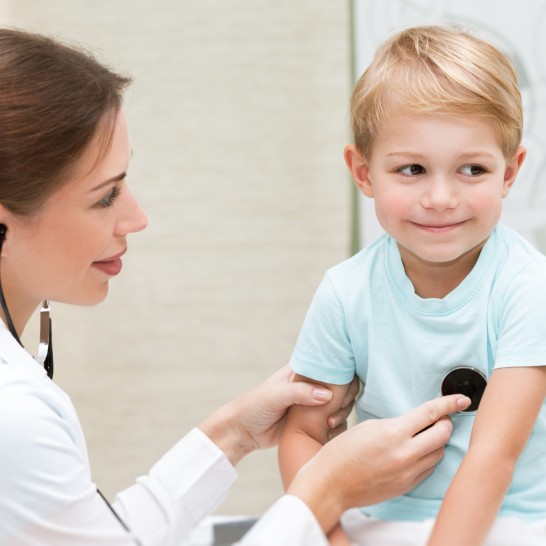
How Does UAS Partner with Providers?
How can healthcare providers balance the demands for more patient quality time and the financial requirements for a sustainable practice? Although it may seem counterintuitive to offer an additional service line, doing so can deliver higher revenue, additional clinical support, and meet rising patient care needs.
Consider In-Office Allergy Testing and Treatment
While over 100 million Americans suffer from environmental and food allergies, only a fraction seek treatment from a specialist. This situation creates an opportunity for providers to offer allergy testing and treatment services inside the practice.
United Allergy Services (UAS) partners with providers to significantly enhance the clinical and financial performance of the practice and improve the lives of patients. We expand access to affordable, high-quality allergy care seamlessly delivered in-office, under the direction and supervision of the on-site provider.
How a Partnership Between Providers and UAS Works
UAS offers a range of options for testing and treatment for patients suffering from allergies, including:
- Food Allergy Testing: UAS tests to identify foods that the patient is allergic to and foods the patient may have a sensitivity or intolerance to. We can rule out a potential food allergy with a negative test. Once a patient’s specific allergies are identified, we then provide educational support regarding what foods these allergens can be found in to help the patient develop strategies to avoid them as best practice.
- Environmental Allergy Testing and Treatment: UAS tests for environmental allergies and then treats the patient with immunotherapy that modifies the underlying allergic condition instead of simply treating the symptoms. Immunotherapy is custom formulated from each patient’s allergy test and individual history, developed on-site at the practice. Treatments can be:
- Allergy shots administered in-office or at home by the patient, or
- Allergy Allay Drops® (UAS’s branded sublingual immunotherapy) administered by the patient at home
There are three UAS partnership structures to choose from:
- UAS-Staffed Allergy Center: Fully staffed with a Clinical Allergy Specialist (CAS) and integrated UAS allergy services imbedded within the practice, with all clinical decisions driven by the provider
- Self-Managed Kit Package: Provider practice receives online learning modules, supplies and customer support for everything needed to provide allergy testing and treatment solutions, with existing practice staff providing and managing the allergy services
- Flexible Hybrid Package: Staffing-only solutions:
- UAS hires and manages an allergy technician for practices that have their own allergy protocols but have a difficult time hiring
- UAS can fully train and support the practice’s employee on the UAS protocol and provide the full range of services, systems and support as in the UAS-staffed model
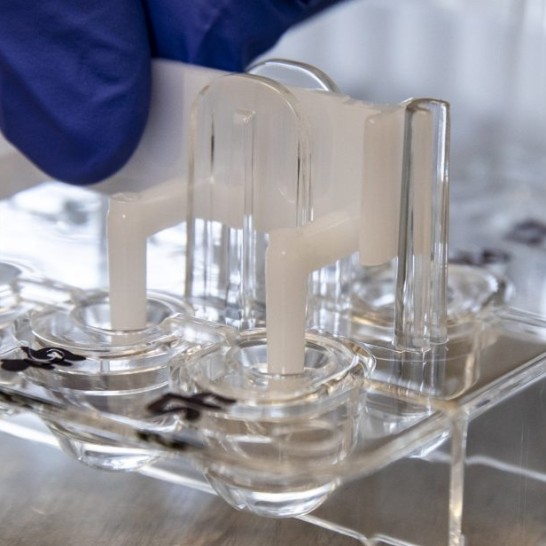
A Win-Win for Providers and Patients
A partnership with UAS enables practices to offer convenient in-house allergy care that improves patient quality of life and satisfaction while generating additional revenue. The practice maintains full clinical control and can easily test, treat and educate patients on environmental and food allergies with comprehensive UAS solutions including practice training, supplies, customer support, patient education tools and marketing materials.
By providing an alternate workstream within the practice, providers can free up their time to attend to other patients who need them while UAS helps take care of the allergy patients.

Why Offer Allergy Care Services in Your Medical Practice?
More than 100 million Americans suffer from environmental, seasonal and perennial allergies, including ragweed, pollen, dust mites and animal dander. In addition, roughly 11% of adults and 7½% of children have a food allergy. Unfortunately, only a fraction seek treatment from a specialist, resulting in an annual cost of $18 billion to the healthcare system and businesses in the U.S.1
Most patients self-medicate with over-the-counter medications, but allergy relief can be elusive. The underlying cause of the condition still goes untreated and leaves patients suffering. The numbers are alarming, as 30% of adults and 40% of children struggle with allergies in the U.S.2
At the same time, providers are getting squeezed between wanting more time for quality patient care and the financial demands that ensure sustainable revenue for the practice.
On-Site Allergy Testing and Treatment
United Allergy Services (UAS) helps by partnering with medical practices to deliver in-office allergy testing for environmental and food allergies. While food allergies are usually dealt with by avoiding the allergen, environmental allergies can be successfully treated via immunotherapy.
Adding this service line improves the lives of patients by expanding access to affordable, high-quality allergy care as a seamless part of the practice and delivers an additional revenue stream to drive financial performance.
Why Immunotherapy?
Allergen-specific immunotherapy has been used to treat environmental allergic issues for over a century. It is the only treatment that addresses the immune dysfunction underlying allergic responses rather than simply treating symptoms or suppressing inflammation. It has been proven safe and effective in treating issues such as allergic rhinitis and asthma and can be offered by a primary care provider without needing to send the patient out to a specialist.3
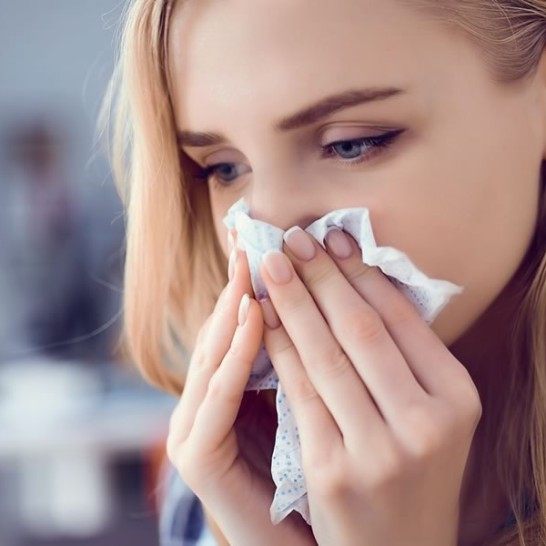
How Partnering with UAS Works
UAS partners with providers to test patients for allergies in the office and then creates a custom formulated immunotherapy from the patient’s allergy test and individual history. Treatments include:
- Customized immunotherapy based on the patient’s history and test results is formulated onsite under provider supervision
- Allergy shots administered in-office or at home by the patient, or
- Allergy Allay Drops® (UAS’s branded sublingual immunotherapy) administered by the patient at home
UAS delivers a range of options for providers, including:
- UAS-Staffed Allergy Center: Fully staffed and integrated UAS allergy services within the practice itself (with all clinical decisions being driven by the provider)
- Self-Managed Kit Package: Provider practice receives online learning modules, supplies and customer support for everything needed to provide allergy testing and treatment solutions, with existing practice staff providing and managing the allergy services
- Flexible Hybrid Package: Staffing-only solutions
- UAS hires and manages the allergy technician for practices that have their own allergy protocols but have a difficult time hiring
- UAS can fully train and support the practice’s employee on UAS protocol and provide the full range of services, systems and support in the UAS-staffed model but with the practice employee operating as the allergy technician
A Win-Win for Patients and Providers
UAS allergy testing and treatment services are proven, flexible, and customizable. They directly meet the allergy health needs of patients without requiring them to go elsewhere, keeping patients – and their dollars – within the provider’s practice.
Click the button below to learn more about working with UAS to add allergy testing and treatment services to your practice.
1 https://www.webmd.com/allergies/allergy-statistics. Accessed 10.31.23.
2 Ibid. Accessed 10.31.23.
3 https://pubmed.ncbi.nlm.nih.gov/27927826/. Accessed 10.31.23.
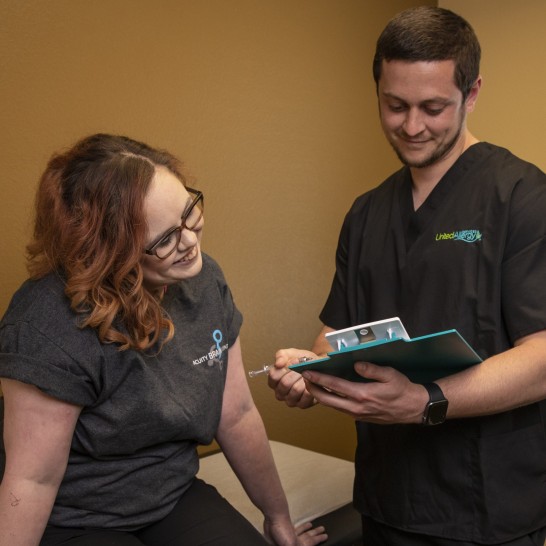
Ancillary Medical Services
In today’s world of declining insurance reimbursements and a multitude of competing options for patients to access care, vibrant, healthy practices are constantly seeking opportunities to grow. Growth can come from expanding your patient base as well as expanding your offerings by offering ancillary medical services to your existing patient base and capturing an increasing share of their healthcare spend.
Growing Your Practice with Ancillary Medical Services
Ancillary medical services can set a practice apart from the competition and enhance its ability to better serve patients. When primary care investment increased, both hospital stays and ED visits decreased, as reported by the Patient-Centered Primary Care Collaborative in 2019.
Allergy assessment and treatment, like that provided by United Allergy Services, is an ancillary service that physicians can offer to both serve patient needs and drive additional revenue into the practice.
Three Steps to Determine Whether Ancillary Medical Services Are Right for Your Practice
Before implementing an additional patient service in a medical practice, take these three steps:
- Consider the current state of the practice
- Qualify the ancillary services vendor
- Determine the cost of investment
1. Reflect on the Practice
The first step is evaluating the practice for untapped potential in both the physical space and services offered. What services are your patients seeking elsewhere either by choice or your referral patterns? These services could be services covered by insurance or they could be consumer-based medical services that your patients are exposed to through other care outlets. The advent of internet-based care outlets has greatly expanded the demand for certain services.
Missed Opportunities
A study published in the Journal of the American Board of Family Medicine (JABFM) noted that physicians are often unable to close the referral loop due to lack of referral completion. In fact, 17% of referred patients do not see the specialist to whom they are referred, according to the JABFM study. Is there a needed service in your community that your practice can fill?
Existing Infrastructure
Available space along with current staff productivity levels and credentials impact the practice’s ability to execute additional patient services. Consider how much time and money it would take for staff education and office renovation before a new service line would be functional in the existing practice.
Patient Evaluation
Alignment with patient needs is critical for the success of any ancillary medical service implementation. Consider the areas of common patient referrals, insurance contracts on file that may influence reimbursement rates, and patient perception of the practice.
17%
of referred patients do not see the specialist to whom they are referred
2. Qualify the Ancillary Medical Services Vendor
Patient care should meet or exceed current practice standards. Ask the vendor:
- What additional patient services do they deliver through implementation and beyond?
- What is their track record?
- What sets them apart from their peers?
Resource Leveraging
A valuable partner will offer provisions that boost the likelihood of success when implementing a new service. Look for available customer support expertise in legal regulations and payer reimbursement for the additional patient services you may onboard. When you meet with a prospective vendor, ask about their expectations regarding qualified candidates for their services and reasonable revenue expectations for the practice.
Vendor Reputation
Partnership with an outside vendor requires a high level of trust. Review the vendor’s references and referrals from colleagues as well as their longevity and experience. Vet potential vendors by researching clinical studies that review the company’s protocols.
3. Determine the Cost of Investment
An expansion of services may require additional resources. Consider the financial investment and the potential ROI opportunity after implementation.
Filling a Gap in the Market
Consider whether adding an ancillary medical service to the practice will be profitable. The most popular ancillary medical services adopted by internal and family medicine are lab services, ECG, prescription dispensing, and radiology/imaging. Adding an ancillary service into a market that is saturated may not be a good business decision. While shopping around for service line vendors, consider what unique market gap you can fill that fits your patient base.
Vendor Buy-In
Choose a vendor with infrastructure to handle not only implementation but staffing and ongoing customer assistance. This backing will help lower upfront costs needed for training and reduce the impact on productivity among existing team members.
What Is Your “Return on Effort“?
Your and your staff’s time is a precious resource. Any investment of time and money should generate a sufficient return to justify the expense. Here are a few questions to answer:
- What is the expected demand for the product or service?
- How will you identify potential patients/consumers?
- What is your investment to initiate the service?
- What is your cost to deliver and maintain the service?
- Is this incremental to your practice, or will this replace or cannibalize some of your existing business?
You do not need an MBA to answer these questions. Your vendor and some common sense can help you answer them. Also, your physician community may have experience with the product or service and can help you develop a simple financial model of the potential revenue and costs.
Does It Work?
Adding a service to a practice should be beneficial for patients and improve ROI for the practice. Adding a service to an existing practice has the potential of improving patient adherence and minimizing the need for referrals overall. 70% of polled physician organization leaders noted that increasing the volume of services delivered is the top action that primary care and specialist physicians could take to increase their compensation.
Take a Look at On-Site Allergy Services
Over 100 million Americans suffer from allergies such as rhinitis (hay fever), food allergies and asthma, but only a fraction seek treatment from an allergist. United Allergy Services (UAS) empowers physicians to offer on-site allergy services that fit seamlessly into existing medical office workflows, expanding delivery of patient services and increasing revenue.
Since 2009, UAS has successfully partnered with more than 2,450 practitioners across 20+ states to deliver proven, flexible and customizable ancillary medical services that directly meet the allergy needs of patients without requiring them to go elsewhere. Treatment protocols include immunotherapy delivered by subcutaneous injections (allergy shots) in the physician’s office or at home as well as sublingual allergy drops self-administered at home by the patient. A UAS treatment group showed >40% improvement in allergy symptom scores compared to control through administration of immunotherapy. A 3-year course of immunotherapy has shown long-term clinical effects and the potential of preventing the development of asthma in children with allergic rhino conjunctivitis up to seven years post-treatment.
UAS medical partners maintain full clinical control and can easily test, treat and educate patients on environmental and food allergies with comprehensive solutions that include staff training, supplies, customer support, patient education tools and marketing materials.
The convenience of in-house allergy care both improves patient quality of life and satisfaction while generating additional revenue for the practice.
Am I Suffering from Allergies? Or Something Else?
There is a wide range of variability from person to person when it comes to allergies. The unique circumstances of each person and their environment as well as what type of symptoms occur, how often they occur, and how troublesome they are all have significant meaning.
Gathering this important clinical information is vital to providers as they are trying to determine if allergies may be playing a role. The ability to identify an association between allergic symptoms and allergen exposures is key and sometimes even definitive in deciding to proceed with allergy testing or immunotherapy.
An easy to use, simple to use, and quick-to-complete symptom screening tool is available in allergy clinics offering United Allergy Service’s line of allergy care options. This screening form offers standardization for this critical initial clinical investigation. It offers the opportunity to focus on seven core symptoms that can be strongly indicative of allergic disease.
The screening tool allows providers to assess the presence of symptoms with a strong indication for allergic disease, the frequency of these symptoms, and the presence of other allergic conditions such as atopic dermatitis and asthma. The greater the symptom score, and the more regular or frequent the symptoms occur, the higher the consideration for an allergy skin test should be. Atopic conditions such as atopic dermatitis and asthma, as well as symptom modifying medication use that has failed to control symptoms, also build more strength in the decision to undergo an allergy test.
This screening tool can also help to capture valuable information even after patients are scheduled for or have already had their allergy test. It can help determine the need for allergy testing and possibly immunotherapy, as well as track the decrease in symptoms and the positive impact immunotherapy has had. Completion of this symptom screening form can also help identify an increase in tolerance to a specific allergen that was previously a trigger, any reduction in medications previously used to lessen allergy symptoms, and any additional clinical benefits noted such as a reduction in asthma exacerbations, sinus infections, ear infections, or dermatitis.
If you feel you may be suffering from allergies, we encourage screening utilizing an allergy symptom screening tool like the one available in UAS allergy clinics or the online allergy quiz available on our website. It’s a great way to start your journey of improving allergy symptoms and your quality of life!
A Deep Dive into Summertime Allergies
As the warmth of summer graces us with its presence, many of us are eager to embrace outdoor activities and soak up the sun. However, along with the barbecues, beach days, and sunny strolls, comes an uninvited guest: allergies. For many people, summer is synonymous with sniffling, sneezing, itchy eyes, and other symptoms that signal the onset of seasonal allergies. Let’s delve into what exactly causes summertime allergies, how they impact us, and what we can do to manage them better.
The Cause: Summer Allergens
Seasonal allergies, also known as hay fever or allergic rhinitis, are triggered by allergens—substances that the immune system mistakenly identifies as harmful. When the body encounters these allergens, it responds by producing a type of antibody called Immunoglobulin E (IgE), leading to an allergic reaction.
During the summer months, the primary culprits are pollens from grasses, weeds, and trees. While spring is most commonly associated with tree pollen allergies, summertime often sees a rise in grass pollens (such as Timothy grass, Kentucky bluegrass, and ryegrass) and weed pollens (like ragweed, sagebrush, and pigweed). Mold spores, which thrive in warm, humid environments, also become more prevalent during summer, contributing to allergic symptoms.
The Impact: Symptoms of Summertime Allergies
The allergic reaction sparked by these allergens can result in a variety of allergy symptoms, many of which can be quite discomforting. These symptoms typically include:
- Sneezing
- Runny or congested nose
- Itchy, watery, or red eyes
- Coughing
- Itchy throat or ears
- Fatigue
These symptoms can severely affect an individual’s quality of life, leading to disturbed sleep, irritability, and an inability to fully enjoy outdoor activities during the summer season.
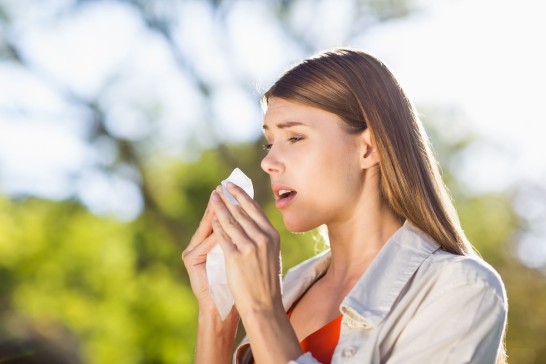
Managing Summertime Allergies
Various strategies can help manage the symptoms of seasonal allergies and make your summer a lot more enjoyable.
1. Awareness and Avoidance
Stay updated on local pollen forecasts available online such as the United Allergy Service Pollen Forecast or through mobile apps such as myAllergyPal®, and try to limit your outdoor activities on high pollen count days. Additionally, during these peak periods, keep your windows closed and use air conditioning to keep allergens at bay.
2. Allergy Medication
Over-the-counter antihistamines can be effective for relieving allergy symptoms like sneezing, itching, runny nose, and watery eyes. Decongestants may also help to relieve a stuffy nose. For those with severe symptoms, a provider may prescribe stronger medications or recommend allergy shots (immunotherapy).
3. Good Hygiene Practices
After spending time outdoors, be sure to shower and change into fresh clothes to remove any pollen that may have settled on your skin and clothing. It’s also beneficial to wash your hands often and avoid touching your face, especially your eyes, to prevent direct introduction of allergens.
4. Home Environment Care
Use high-efficiency particulate air (HEPA) filters in your home to trap pollen and other allergens. Regular cleaning and vacuuming also help to keep your indoor environment allergen-free.
The Solution: Lasting Allergy Relief
Despite best efforts to manage allergy symptoms, over-the-counter medications and preventative measures might not be enough for some individuals. In such cases, it’s crucial to take the next step—getting tested for allergies. By identifying specific triggers, you can not only avoid those allergens but also receive targeted treatment for more effective symptom relief.
Through your provider at an allergy center near you, United Allergy Services offers comprehensive allergy testing that can pinpoint the exact allergens causing your discomfort. This personalized approach allows for a more accurate diagnosis and effective treatment plan.
For some, the path to relief could lie in immunotherapy, a treatment approach that helps the body build tolerance to allergens. United Allergy Services offers allergy shots (subcutaneous immunotherapy) and allergy drops (sublingual immunotherapy) tailored to your specific allergen sensitivities. Over time, immunotherapy can help to reduce or even eliminate your allergic responses, enabling you to fully enjoy summer.
In conclusion, while summertime allergies can put a damper on this vibrant season, there are many avenues to manage and overcome them, including avoidance, medication, and medical treatments like immunotherapy. Don’t let allergies hold you back—explore options with your provider at a local allergy center to find the best treatment path for you.
FSA/HSA Plans for Allergy Services
Environmental allergies are a common ailment that affects approximately 50 million Americans every year. Whether you suffer from year round or just seasonal allergies, you may be able to use your tax-free FSA/HSA funds to help you save money on education, testing, and treatments. If you struggle with allergy symptoms—itchy eyes, congestion, and non-stop sneezing—you know how tough the spring and summer months can be. Over-the-counter drugs can help, but sometimes these remedies aren’t enough. As you compare options, you may notice the hefty price tag. Luckily, your health savings account (HSA) or flexible spending account (FSA) may offer some savings to your allergy relief.
What Exactly is an FSA or HSA Health Care Plan?
Flexible Spending Accounts (FSA) or Health Savings Accounts (HSA) are medical savings accounts with tax benefits, designed to allow you to set aside pre-tax savings to go towards your treatments, healthcare and other medical expenses.
Can I Use My FSA/HSA Plan for Allergy Testing?
For the majority of healthcare plans environmental and food allergy testing is an eligible FSA/HSA expenditure, meaning they allow the tests as a qualified medical expense. To make sure you're covered, we recommend getting in touch with your provider to confirm your inclusions.
A qualified medical expense is defined in IRS Publication 502 as the cost of treatment, cure, diagnosis, mitigation or prevention of a disease. The expense must be used principally to prevent or help ease the symptoms of a physical/mental illness or disability in order to meet the criteria for HSA and FSA. Environmental sensitivity tests work to identify allergic triggers that may cause discomfort and allow you to avoid or mitigate the exposure. Similarly, food sensitivity tests identify digestive issues so you can alter your diet to try and prevent things like bloating, nausea and stomach cramps.
Other Allergy Related Questions?
Our team wants to help you make the most out of your benefits before they expire on January 1st. Visit our FAQ page for more insight, or find an Allergy Center near you by clicking here.
Oral Allergy Syndrome
Delicious, ripe, mouthwatering fruits and vegetables are more plentiful during these summer months. However, that that summer breeze may carry more than just excitement for the season. Some people with environmental allergies may notice that certain fruits, vegetables, or nuts give them distinct allergic symptoms, typically confined to the lips, mouth and throat. This phenomenon is known as oral allergy syndrome (OAS).
Oral Allergy Syndrome
Oral allergy syndrome, or pollen food allergy syndrome, occurs when there is a cross reaction or a confusion in the body. Some fruits, vegetables, and nuts have a similar protein to the allergy-causing protein on the surface of the pollen grain. According to the American Academy of Allergy, Asthma, and Immunology (AAAAI), "These proteins can confuse the immune system and cause an allergic reaction or make existing allergy symptoms worse, which is referred to as cross-reactivity." It is a contact allergic reaction, but it also considered a mild food allergy.
Cross Reactivity
During the summer season, cross reactivity with grass and weed pollen most commonly triggers OAS. Timothy grass, orchard grass, and ragweed pollen tend to cause more reactions. Other grasses and weeds may also contribute to OAS symptoms. People with allergy to timothy grass and orchard grass may experience OAS when consuming foods like peaches, oranges, and tomatoes. Those allergic to ragweed pollen can experience symptoms when eating foods like banana, cucumber, zucchini, and some melons such as honeydew and cantaloupe. Watermelon and white potatoes can trigger a response in both grass and weed pollen sufferers equally.
Symptoms and Treatment
Typically, oral allergy syndrome symptoms present as itching or swelling in the mouth and throat. Symptoms can also be present on the face, lips, or tongue. While the symptoms usually appear immediately after eating raw fruits or vegetables, in rare cases the reaction can occur more than an hour later. Eating the food in the rawest or purest form usually triggers the more severe symptoms. Peeling, cooking, or baking the food can greatly reduce or eliminate a reaction all together.
For most people, the allergy symptoms are localized to their mouth and are uncomfortable or annoying. However, up to 9% of people have reactions that affect a part of their body beyond their mouth. About 1.7% can suffer a life-threatening allergic reaction or anaphylaxis. For this reason, it is crucial for people to determine what might be causing their symptoms with allergy testing and food journals. Avoid eating that allergy-causing food (especially in that foods peak allergy season). It is also beneficial to consider treating the underlying pollen allergy with immunotherapy.
Amanda Hofmann, MPAS, PA-C, is a graduate of Duquesne University, in Pittsburgh, PA. After spending 8 years in clinical practice, she joined United Allergy Services where she is currently the Vice President of Clinical. Amanda is also the past president of the Association of PAs in Allergy, Asthma, and immunology.
United Allergy Services is also on Facebook, LinkedIn, or Twitter.
Eosinophilic Esophagitis (EoE)
Eosinophilic esophagitis (EoE) is a recognized diagnosis that produces symptoms related to dysfunction of the esophagus. In EoE, large amounts of white blood cells, specifically eosinophils, collect in the inner lining of the esophagus resulting in inflammation. Typically, the esophagus is free from eosinophils and resulting inflammation, and so in EoE, a patient will begin to notice a difference in the way they can eat and swallow food. This condition can be difficult to diagnose as other conditions can present with eosinophils in the esophagus, and historically EoE has not been a common or well-known disease. Awareness has significantly improved however in the last decade, and patients are being recognized and diagnosed much earlier. This week, the FDA has approved the first ever treatment for EoE.
Symptoms of EoE
Many EoE patients also have symptoms of one or more allergic disorders like asthma, allergic rhinitis, atopic dermatitis (eczema) and food allergy. It is important for EoE patients to be properly assessed and tested for potential allergens as well as properly diagnosed for their atopic conditions. Similar to proper diagnosis, it is crucial that any and all allergic aspects of EoE can be properly treated in conjunction with management of the EoE. Patients benefit from a team of providers working together such as a primary care provider, allergy specialist, and gastroenterology specialist.
Early diagnosis of this chronic condition is important so patients can be educated and properly managed, sparing them from discomfort, malnutrition, and even life-threatening situations. An emergent situation can arise if inflammation becomes too great and causes narrowing in the esophagus, trapping swallowed food. In younger children, EoE typically presents with poor feeding, failure to grow properly, vomiting, reflux symptoms, and abdominal pain, whereas in adolescents and adults EoE most often presents with dysphagia (trouble or painful swallowing) and emergent esophageal food impactions.
Allergy Correlation
Airborne allergies can play a role, however adverse immune responses to food are the main cause of EoE in many patients. It can be more difficult to properly diagnose food allergies in EoE patients because many do not present with the typical symptoms associated with IgE mediated food allergy. Instead of immediate itching, flushing, hives and vomiting after ingestion of the offending food, the reactions can be delayed over hours or days. Milk, egg, soy and wheat are recognized as the most common triggers for EoE, however, conventional allergy tests often fail to detect sensitivity to the foods causing EoE. This is because most food allergy reactions in EoE are delayed and caused primarily by immune mechanisms other than classical IgE-mediated food allergy.
Diagnosis
Other than proper identification and diagnosis of atopic conditions, EoE must also be properly diagnosed itself as a disease. If EoE is suspected, a specialist performs an upper endoscopy, where a small tube with embedded camera is passed down the esophagus. The tube not only has a camera and light for inspection, but a small device to take samples, or biopsies of the esophagus. The biopsies of the esophagus are examined under a microscope for eosinophils and inflammation and are necessary to diagnose EoE. A provider looks for appropriate symptoms that were described above, visual inspection of the esophagus, and examination of tissue biopsies to make the final diagnosis of EoE.
Managing EoE
There are many viable options to managing EoE effectively. Food sensitivities or allergies can be managed by removing those offending foods from a person’s diet, but only under the direct guidance and supervision of a provider. A provider can advise eliminating a specific food, or a food group based on individual history, examination, and diagnosis. This elimination approach can be helpful to some, but it is important to only remove what is advised, and a medical provider will closely monitor a person and regularly discuss nutrition and intake. Many times, a dietician is added to the medical care team to make sure a person is still receiving all the necessary nutrients. A provider’s goal is to carefully add back any foods that can in fact be tolerated and are proven not to incite eosinophils in the esophagus.
Aside from adjustments to a person’s diet, there are some medications providers use to help provide symptom relief and management of the EoE. It is important to note that aside from the first medication being approved by the U.S. Food and Drug Administration (FDA) to treat EoE, typical options for treatment include proton pump inhibitors and steroids. Proton pump inhibitors (PPIs) reduce acid production in the stomach and have also been found to be able to reduce esophageal inflammation in some patients with EoE. PPIs are very commonly used as a frontline therapeutic for EoE patients. If PPIs do not work for a patient, another option may be swallowed topical corticosteroids. Swallowing small prescribed doses of corticosteroids so they come in direct contact with and treat the inner lining of the esophagus is the most common treatment.
Amanda Hofmann, MPAS, PA-C, is a graduate of Duquesne University, in Pittsburgh, PA. After spending 8 years in clinical practice, she joined United Allergy Services where she is currently the Vice President of Clinical. Amanda is also the past president of the Association of PAs in Allergy, Asthma, and Immunology.
United Allergy Services is also on Facebook, LinkedIn, or Twitter. See other interesting and related articles on the UAS Blog.
Are Hypoallergenic Pets a Real Thing?
Are you one of those people that think life without a furry friend is unimaginable? You aren’t alone. In fact, millions of dedicated pet owners even suffer through pet related allergy symptoms because life without a fur-baby isn't an option for them. In a growing trend, many steadfast animal lovers are turning to “hypoallergenic” pets in hopes of keeping the allergy symptoms at bay.
What Does Hypoallergenic Mean?
Pet allergies can display in many ways including sneezing, runny nose, coughing, chest tightness, shortness of breath and even allergy induced asthma. The term hypoallergenic is defined as “designed to reduce or minimize the possibility of an allergic response; as by containing relatively few or no potentially irritating substances.” Applying this term to personal care products such as lotions and detergents makes sense. However, applying this label to animals is a little more difficult.
Most often, people believe the pet’s fur and shedding causes the pet allergy. Typically, because of this belief, pets that are hairless, do not shed, or shed minimally are called hypoallergenic. However, the main trigger for pet allergy is in the protein produced by the pet, not their fur. These proteins are carried on small, easily inhalable particles with the highest concentration found in the pet dander. Pet dander is the dead flaky skin that all warm blooded mammals produce. Substantial amounts of protein are also found in the animal’s saliva and urine.
Are Hypoallergenic Pets a Real Thing?
Some breeds may cause fewer problems for allergy sufferers. Because of grooming habits or shedding patterns, allergen exposure can be less in these cases. Both dogs and cats have the potential, however, to release allergens into the air you breathe. The proteins are present in all breeds, including those that some claim to be hypoallergenic. Cats tend to cause more allergic reactions than dogs because they groom themselves more often. Unfortunately, birds, and smaller mammals such as guinea pigs, rabbits, hamsters, and chinchillas also produce dander. On the bright side, because these animals are much smaller and typically dwell in contained spaces, they may provide less allergen exposure and therefore less symptoms. Snakes, frogs, lizards, turtles, and fish do not have the dander issue. Reptile friends can be great options for allergy sufferers desiring pet companionship.
There are Options
Everyone is different, and every family is faced with different challenges when it comes to choosing the right pet. The most effective way to protect your household from pet allergens is not to have any warm-blooded pets. For millions of animal lovers, though, this is unlikely option. Researching animals that produce less dander, saliva, and are low/non shedders is a great start.
Although there is no amount of cleaning that will eliminate all dander from a home, there are some best practices. Cleaning your house and bathing your pets regularly is the first step. Also, keeping pets out of bedrooms, off carpets, and off upholstered furniture can help. The goal is to minimize the concentration of allergens and in crucial places such as family gathering rooms and sleeping areas.
Another option of course, besides the avoidance measures listed above, is to consider the benefit of allergen immunotherapy for anyone suffering a pet allergy.
______________________________________________________________________________________________________________________
Amanda Hofmann, MPAS, PA-C, is a graduate of Duquesne University, in Pittsburgh, PA, and spent 8 years in clinical practice before joining United Allergy Services. She is the Vice President of Clinical at UAS and the past president of the Association of PAs in Allergy, Asthma, and immunology.
For more interesting insight from United Allergy Services, visit us on Facebook, LinkedIn, or Twitter.





